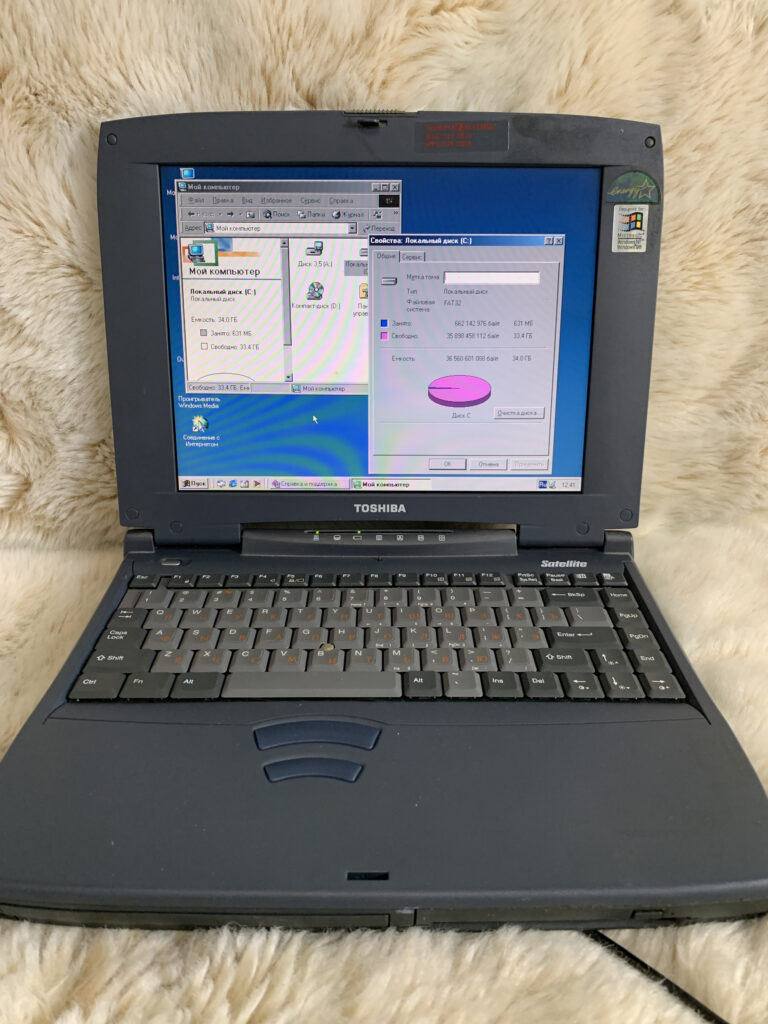Testing Li-ion batteries. Checking batteries for authenticity
Goals and objectives
Check batteries from world brands for compliance with the declared characteristics.
Check the authenticity of Li-ion batteries sold on marketplaces by suppliers from China.
Check to what extent the rating and review system on marketplaces can serve as a basis for choosing a product.
Process
We select batteries from well-known brands and large suppliers with a large number of positive reviews and high ratings on trading platforms.
Batteries are divided into two groups:
the first group – batteries from suppliers from China;
the second group is batteries from large international brands.
Batteries are tested with maximum permissible currents. The complex internal resistance is measured. Analysis of results.
A reference battery will be added to each group for comparative analysis.
Reference battery – a battery with conditionally reference parameters, known to be genuine and without manufacturing defects.
Battery selection criteria
Trademarks must be recognizable. Battery models must have a significant number of reviews and a high rating on marketplaces. In addition, batteries must be mentioned on third-party resources in reviews or reviews.
First group
Batteries: LiitoKala HG2, EAIEP HG2 (hereinafter referred to as LiitoKala and EAIEP).
The rating of these batteries on AliExpress is 4.9-5 out of 5. The number of reviews is more than 1000. According to reviews and reviews on independent forums and blogs, the batteries are of high quality.
Reference battery LG HG2 LGDBHG21865 (hereinafter referred to as LG).
Second group
Batteries: Skilhunt, Olight and KLARUS.
The listed brands are represented on marketplaces in Europe and the USA, as well as in offline networks. Present on Amazon, Walmart and other sites.
Reference battery Panasonic NCR18650GA (hereinafter referred to as Panasonic).
Let's explore the first group
LiitoKala and EAIEP batteries are trying to imitate the Korean LG HG2 LGDBHG21865. Not only the color and shape of the contacts are repeated, but also the markings. Both batteries are marked as “DBHG21865”, but in place of the “LG” symbols there is a sticker with the LiitoKala or EAIEP logo. This is probably done to avoid blocking by the marketplace.

Table 1 – Battery characteristics
Name | Nominal capacity | Maximum discharge current |
LiitoKala | 3000 | 25 |
EAIEP | 3000 | 25 |
LG | 3000 | 20 |
Measurements
The characteristics of LiitoKala and EAIEP batteries indicate a maximum discharge current of 25A.
Since the maximum discharge current of the LG reference battery is 20A, measurements will be made with a current of 20A.
Test mode:
– discharge current 20A;
– direct current discharge;
– minimum discharge voltage 2.5V.
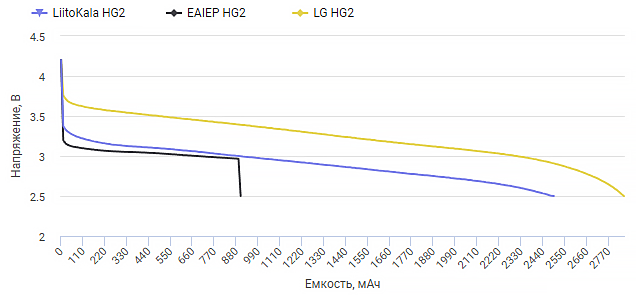
LiitoKala and EAIEP batteries exhibit an avalanche-like voltage drop.
The EAIEP graph ends at 905mAh. This is due to the activation of the emergency pressure valve. The battery is irreversibly damaged.
It is obvious that the real parameters of LiitoKala and EAIEP do not correspond to the declared ones.
If you repeat the test with a current of 2A, then the LiitoKala and EAIEP batteries show the result within normal limits.
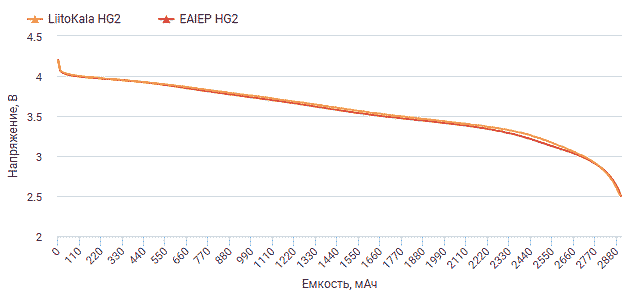
That is, these are indeed batteries with a capacity of 3000 mAh, but they are not high-current. Under the guise of high-current batteries, ICR batteries are sold that are designed for a discharge current of no more than 3-4A.
Internal resistance
The complex internal resistance of a battery is one of the most important parameters. The higher the resistance, the greater the losses, the higher the heating and the lower the discharge current the battery can provide.
Measuring internal resistance allows you to determine in absentia the maximum power of the connected load. For high-current batteries, the internal resistance usually does not exceed 18 mOhm.
Let's measure the internal resistance of the batteries.
Table 2 – Internal resistance
Name | Internal resistance, mOhm |
LiitoKala | 28 |
EAIEP | 35 |
LG | 15 |
Now if you go back and compare schedule 1 and Table 2, then a correlation between the internal resistance and the discharge graphs will become noticeable. Resistance of 28 and 35 mOhm exactly corresponds to ICR batteries. That is, the version of “repackaging” inexpensive ICR batteries into expensive high-current ones is confirmed.
Misconception
Most household chargers and measuring devices measure a discharge current of no more than 2A. And as we see on schedule 2, at such low currents, even fake batteries show the declared capacity. This creates the illusion that the batteries are genuine.
However, when using batteries in real devices, where the current consumption can reach 20-30A, the battery is destroyed or rapidly degrades.
Manufacturers of cheap cordless tools can use just such batteries in their tools. As a result, batteries quickly lose capacity or fail. This means that fast charging “kills” the batteries, in the cold the capacity “leaks”, and so on.
Although this is all due to the use of batteries in modes for which they are not intended.
Let's explore the second group
Batteries: Skilhunt BL-135 PCB, 3500 mAh HD PCB and KLARUS 3600mAh PCB
(hereinafter referred to as Skilhunt, Olight and KLARUS).
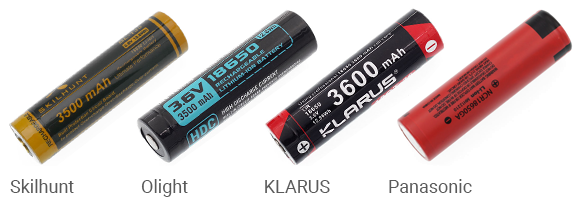
All of the listed batteries are equipped with an electronic protection board, that is, they are not a cell in its pure form. Essentially, this is an electronic device consisting of a Li-ion battery and a control board.
They are made on the basis of a Panasonic NCR18650GA battery (hereinafter referred to as Panasonic). This battery will be the reference one.
Measurements
All batteries, with the exception of Olight, showed results that were poorly distinguishable from the reference Panasonic.
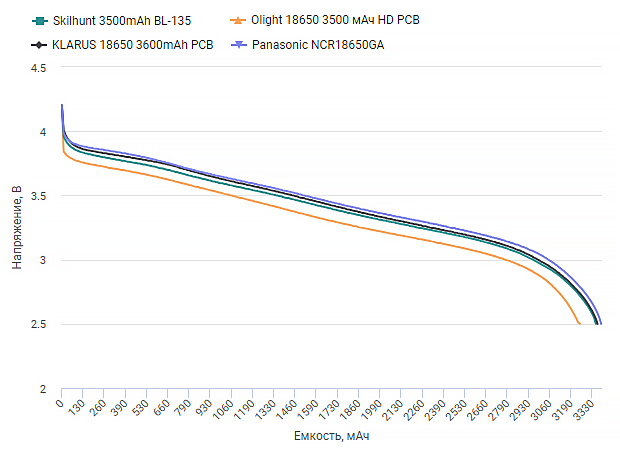
Table 3 – Battery parameters
Declared capacity | Capacity measured (5A), | Maximum discharge current, | Internal resistance, mOhm | |
Panasonic | 3450 | 3378 | 10* | 23 |
Skilhunt | 3500 | 3351 | 8 | 31 |
Olight | 3500 | 3248 | 10 | 46 |
KLARUS | 3600 | 3356 | 7 | 27 |
* Subject to temperature conditions
No, despite the fact that the batteries use the same Panasonic NCR18650GA cell, the values of capacity and maximum discharge current are declared different. Moreover, all manufacturers have a declared capacity higher than that of the Panasonic NCR18650G cell used.
Olight 3500 mAh HD PCB is claimed to be high current, with a maximum discharge current of 10A. Therefore, we will test Olight with a discharge current of 10A
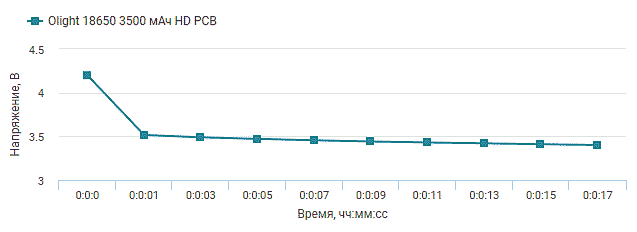
In the first fractions of a second, the voltage drops like an avalanche. At 17 seconds, the electronic protection board is triggered and the battery is turned off. That is, both the protection board and the cell itself are not designed for a current of 10A.
Experimentally, I selected a battery whose graphs were as similar as possible to the Olight graphs. This battery turned out to be Panasonic NCR18650B.
When Olight and Panasonic graphs are superimposed, the graphs merge into one.
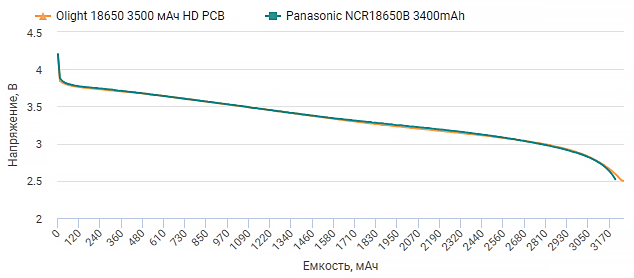
We can't say for sure that Olight uses a Panasonic NCR18650B cell, but at least it uses something similar to a Panasonic NCR18650B.
The capacity of Panasonic NCR18650B is 3350mAh, the maximum discharge current is only 4.9A.
conclusions
Even large Chinese suppliers sell fakes. This does not prevent you from having a high rating for the store and individual products.
Rating and review systems on marketplaces are of questionable reliability. Reviews on third-party resources are also not always objective due to incorrect measurements or incorrect interpretation of data.
Large brands tend to overstate the specifications, but in most cases exactly the cells that are declared are used. However, even among large brands, cases of forgery of the element base are possible.
It makes no sense to select batteries by comparing the declared characteristics. It is more important to determine which cell is installed inside. Then start from the characteristics of the cell itself and the accompanying element base.
